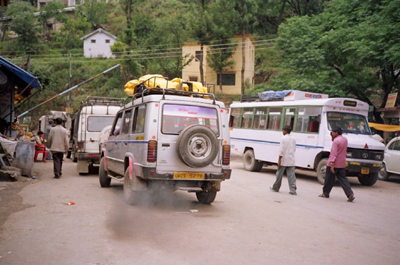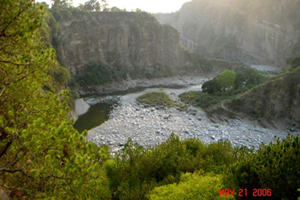Ganga after Tehri Dam
-Saraswati Kavula
On a recent trip to Delhi, I decided to pay a visit to the Gomukh Glacier at Gangotri from which Ganga takes her birth. For the simple reason, that I had never seen a glacier before. My first stop
was Haridwar on a train, and then a local bus to Rishikesh. On the bus from Haridwar to Rishikesh, a lecturer from Lucknow University was sitting beside me. He was pointing out the various sites to be seen at Haridwar. As the bus took the turn out of the town,
we found a huge barrage on the Ganga. My fellow traveller pointed out, “This year, there was not much water at Haridwar. Only now, you are able to find this much water, since they started releasing the water from Tehri’ I asked him, ‘Do you come here often?’
‘Yes, we come every year, but ever since the dam has been constructed, the water levels in the Ganga had gone down. Only when they release the water from the dam, it increases’.

I stopped at the Garhwal Mandal Vikas Nigam to find out the route to Gangotri and about places to stay. They recommended that I take a package tour which allows me to visit Gangotri and Yamunotri
(The Birth place of River Yamuna) in six days time. After some contemplation, I declined and said I preferred to go on my own. So the lady told me to take a share taxi and make a stop either at Chamba or Uttarkashi. ‘Chamba is a lovely place; you will get
to see lots of mountain views. But since, it will be a longer journey from Chamba to Gangotri, you better stop over at Uttarkashi tonight. Even Uttarkashi is a lovely place. You will surely enjoy the stay there’.
So, from Rishikesh to Uttarkashi I travelled in a share taxi. The mountains above Rishikesh were wooded but not after a distance. On our way up we passed through Chamba. I tried to see what
was great about the place. Chamba was supposed to be a summer retreat, but the temperatures were crossing 30 degree Celsius. I could only see degraded land, and barren mountains, with hardly any forest, all the way beyond Narendra nagar up to Chamba and Uttarkashi,
except for some plantations, which were developed by the Forest department; a dusty town, with loads of plastics and trash tucked away in corners not seen from the main roads. It has pained me, for I was fond of the Himalayas very much, and was nearly visiting
them after eight years. I do not remember seeing this many years ago.
We stopped at the Tehri Reservoir to have some tea. The taxi driver pointed out and said, “this is the reservoir.’ I said then, ‘but there was a lot of opposition to the dam isn’t it? Lot
of villages got submerged?’ One of the fellow traveller in the taxi said, ‘yes, but people got compensated heavily, some people even cheated and got paid four times over’.
Then I said, ‘well, they might be the people in power like the sarpanch and mukhiya. Since, all over India, where ever they made dams, people have not received proper compensations, many of our people who got displaced in Nagarjunasagar, are living like
beggars even today’. The tea shop man said, ‘you are right madam, those who got compensated four times over were the powerful, many poor and powerless people did not receive compensation’. The tea shop man’s village was down below on the banks of the reservoir.
‘Earlier the distance between Tehri and Uttarkashi was 70 kms, today it has increased to 140 kms between New Tehri and Uttarkashi. So, our travel time has increased by two hours. On the other hand, this man would not have had his tea shop before the construction
of dam. This is the paradox’, added one of the local men who were having tea there. Sure enough the reservoir was beautiful, but was placid and not flowing like the river.

The road to Uttarkashi is quite breathtaking, but one finds the valley bereft of the famed waters, and one could only find dry beds in many places. Uttarkashi might once have been a pristine
little place, a base camp for the Nehru Institute of Mountaineering, but today, it is a bustling town with new high rise buildings and hotels coming all over the place, eating into the mountainside. Everywhere one finds, smoke spewing vehicles on the Gangotri
Highway. Being the pilgrim season, the entire place had the look of a busy road in a big city. The food was good, albeit not local food, it was Punjabi or Gujarati or even South Indian, but one could not find the local food anywhere. Not very surprising though!
Tourist demand does it! After a night stay on the noisy street in a small hotel, I left for Gangotri the next day morning. The bus was some sight. People were trussed like sardines inside it; it is no wonder that travel sickness is very common in the bus and
of course, helped the rent-a-car business very much. I hopped on to a share taxi once again and was off on the way up to Gangotri. Here too similar sights greeted me – loads of non-degradable trash lining the walls of the valley, which no doubt will join the
river pretty soon. All the way to the high mountains, one could see small hotels, motels lining the roads, not leaving much space for an unhindered view.
Photographs “Dry River Bed” -Kishan Rao,
Gangotri Highway-Saraswati Kavula
( To be continued.)